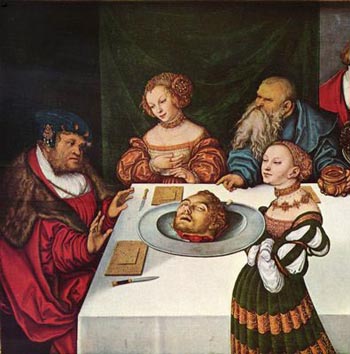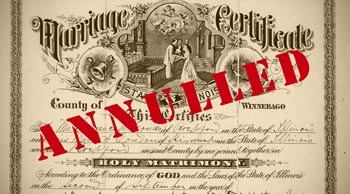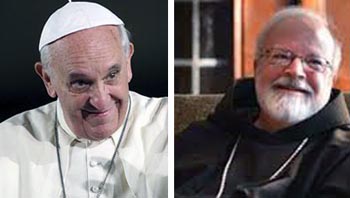Morals
 |
 |
 |
 |
 |
 |
 |
The Gravity of Matrimony
St. John the Baptist incurred the fanatical hatred of Herodias for rebuking her illicit marriage to the Tetrarch Herod Antipas. His words were, “It is not lawful for thee to have her” (Matt 14: 4).
In fact, it was to placate the hatred of the cruel and shameless Herodias that the Tetrarch had cast John into prison. But the hateful woman, who had a fatal influence over him, would be satisfied with nothing less than the death of John the Baptist, her “most dangerous foe.” (1)
 The opportunity for her crime came during a great banquet, arranged for Herod's birthday. Salome, the daughter of Herodias, performed a dance for Herod and his dinner guests. At that time, she would have been close to age 20. Her performance was more than indecent, Fr. Fillion tells us in his Life of Christ, it was a veritable degradation.
The opportunity for her crime came during a great banquet, arranged for Herod's birthday. Salome, the daughter of Herodias, performed a dance for Herod and his dinner guests. At that time, she would have been close to age 20. Her performance was more than indecent, Fr. Fillion tells us in his Life of Christ, it was a veritable degradation.
The performance of Salome captured the attention of all and succeeded in winning the favor of the Tetrarch. Overheated with wine, he foolishly promised to give her whatever she requested, “even if it be half of my kingdom.” (2)
Instructed by her mother, Salome said: “I desire that you give me here in a dish the head of John the Baptist” (Matt. 14: 8). The iniquitous order was promptly carried out, and, after a short absence, the soldier returned to the banquet hall, carrying upon a blood-smeared platter the head of the Baptist, and placed it in the hands of Salome. (3)
Centuries later two more heads would fall to the axe for analogous reasons. John Fisher and Thomas More were strongly and openly opposed to Henry VIII's decision to set himself up as Supreme Head of the Church in England.
The King's motive was not primarily theological; he wished Rome to nullify his marriage to Catherine of Aragon and Rome refused. Henry’s sanctimonious excuse to break with Rome was based on his pretension that God's will was that he should do so, since he was without a male heir.
The Bishops capitulated to the King’s desire. The English Bishops listened with docility, and their spokesman, the old Archbishop Warham, gave their answer. “This is true, if it pleases Your Highness. I doubt not that all my brethren here will affirm the same.” (4) There was a sudden stir in the packed room as plans went awry. John Fisher's voice rang out through the room: “No, Sir, not I. Ye have not my consent thereto.” (5) The King’s Chancellor Thomas More later took the same stance. And so St. John Fisher and St. Thomas More faced the same fate as St. John the Baptist.
Mutatis mutandis, it is hauntingly remindful of the Bishops of our own time who have taken such lax attitudes on marriage annulments.
Where we are today
It is hardly necessary to grapple with statistics. Still, it is useful to see some figures to have an idea of the great change in the annual number of annulments in the United States pre- and post-Vatican II.
 Prior to the Council there were some 300 annulments annually in the United States; after it, more than 30,000 per year with a peak of 63,933 in 1991. (6)
Prior to the Council there were some 300 annulments annually in the United States; after it, more than 30,000 per year with a peak of 63,933 in 1991. (6)
Faced by this ocean tide of annulments - many granted quickly and based simply on “psychological reasons” or “immaturity” - morally speaking, every Catholic worthy of the name wonders how such a grave thing as the marriage vow can be so easily dissolved.
I believe that there are three causes for these annulments:
On February 20-21, 2014, Pope Francis will meet with the Cardinals just before Saturday’s consistory, where 19 new Cardinals will be created. One burning issue on the table for discussion will be relaxing rules for Catholics who divorce and remarry without an annulment to receive Communion and the other Sacraments of the Church. This session with the Cardinals will set guidelines for the Synod of Bishops that will gather to discuss the family and marriage in October.
Some are feeling the smell of a compromise in the air. (7) Since a doctrinal issue is involved, there are Prelates who are inclined to grant permission for a person remarried without an annulment to receive the Sacraments.
 Other ideas are being “floated,” as well, to loosen the Church’s supposedly stern laws on marriage. Card. Sean O’Malley of Boston suggests speeding up the annulment process, eliminating appeals to Rome. Also, a group of Italian canon lawyers argues the grounds for annulments should be expanded. That would include the excuse of “mama-ism” – that one spouse was too much under the control of his or her “mama” and so unable to make a mature judgment.
Other ideas are being “floated,” as well, to loosen the Church’s supposedly stern laws on marriage. Card. Sean O’Malley of Boston suggests speeding up the annulment process, eliminating appeals to Rome. Also, a group of Italian canon lawyers argues the grounds for annulments should be expanded. That would include the excuse of “mama-ism” – that one spouse was too much under the control of his or her “mama” and so unable to make a mature judgment.
A progressivist journalist summarizes the situation: “Faster, easier, and cheaper annulments may be a way to give everybody at least some of what they want – upholding the indissolubility of marriage, but also providing millions of divorced and remarried Catholics an exit strategy from their form of limbo.” (8)
St. John the Baptist was beheaded because he refused to recognize Herod’s illicit marriage. St. John Fisher and St. Thomas More were also put to death for not accepting the King’s divorce and remarriage.
Today we are witnessing mass capitulation due to the denial of the gravity of the Sacrament of Marriage and its marriage vows. Marriage is a Sacrament intended to lead the participants to salvation. Today, under the black cloud of Progressivism it has been turned into a burlesque rock-'n-roll.
Let us ask Our Lady and St. Joseph, the world's most perfect example of matrimony, to end this moral insanity that, by its very nature, is the cause of broken homes and scattered children.

In fact, it was to placate the hatred of the cruel and shameless Herodias that the Tetrarch had cast John into prison. But the hateful woman, who had a fatal influence over him, would be satisfied with nothing less than the death of John the Baptist, her “most dangerous foe.” (1)

Salome receiving the head of the Baptist from Herod
The performance of Salome captured the attention of all and succeeded in winning the favor of the Tetrarch. Overheated with wine, he foolishly promised to give her whatever she requested, “even if it be half of my kingdom.” (2)
Instructed by her mother, Salome said: “I desire that you give me here in a dish the head of John the Baptist” (Matt. 14: 8). The iniquitous order was promptly carried out, and, after a short absence, the soldier returned to the banquet hall, carrying upon a blood-smeared platter the head of the Baptist, and placed it in the hands of Salome. (3)
Centuries later two more heads would fall to the axe for analogous reasons. John Fisher and Thomas More were strongly and openly opposed to Henry VIII's decision to set himself up as Supreme Head of the Church in England.
The King's motive was not primarily theological; he wished Rome to nullify his marriage to Catherine of Aragon and Rome refused. Henry’s sanctimonious excuse to break with Rome was based on his pretension that God's will was that he should do so, since he was without a male heir.
The Bishops capitulated to the King’s desire. The English Bishops listened with docility, and their spokesman, the old Archbishop Warham, gave their answer. “This is true, if it pleases Your Highness. I doubt not that all my brethren here will affirm the same.” (4) There was a sudden stir in the packed room as plans went awry. John Fisher's voice rang out through the room: “No, Sir, not I. Ye have not my consent thereto.” (5) The King’s Chancellor Thomas More later took the same stance. And so St. John Fisher and St. Thomas More faced the same fate as St. John the Baptist.
Mutatis mutandis, it is hauntingly remindful of the Bishops of our own time who have taken such lax attitudes on marriage annulments.
Where we are today
It is hardly necessary to grapple with statistics. Still, it is useful to see some figures to have an idea of the great change in the annual number of annulments in the United States pre- and post-Vatican II.

Rubber-stamped and rolling out fast
from the diocesan offices
Faced by this ocean tide of annulments - many granted quickly and based simply on “psychological reasons” or “immaturity” - morally speaking, every Catholic worthy of the name wonders how such a grave thing as the marriage vow can be so easily dissolved.
I believe that there are three causes for these annulments:
- Vatican II inverted the main goal of marriage from having children and raising them well to the love of the spouses. What was a serious objective end, procreation, passed overnight to be a disputable subjective purpose, love. With this subjective and in some ways hedonistic goal affirmed as supreme, many marriages were at stake. Before, the rule was: a marriage must continue even without love; today, it became: without love a marriage must end, even if there are children.
- After the Council, priests stopped speaking from the pulpits and in the confessionals about the gravity of marriage and obedience to its vows. Instead of resisting the world’s lack of morality or immorality, Catholics increasingly follow these bad trends since they lack clear-cut direction.
- The post-conciliar Popes, instead, established that any Bishop’s tribunal can annul a marriage, making it incredibly easy to get an annulment and, by doing so, raised an unnecessary temptation for married couples and disturbed Catholic family stability.
On February 20-21, 2014, Pope Francis will meet with the Cardinals just before Saturday’s consistory, where 19 new Cardinals will be created. One burning issue on the table for discussion will be relaxing rules for Catholics who divorce and remarry without an annulment to receive Communion and the other Sacraments of the Church. This session with the Cardinals will set guidelines for the Synod of Bishops that will gather to discuss the family and marriage in October.
Some are feeling the smell of a compromise in the air. (7) Since a doctrinal issue is involved, there are Prelates who are inclined to grant permission for a person remarried without an annulment to receive the Sacraments.

O'Malley proposes even easier annulments; Francis calls for more mercy
A progressivist journalist summarizes the situation: “Faster, easier, and cheaper annulments may be a way to give everybody at least some of what they want – upholding the indissolubility of marriage, but also providing millions of divorced and remarried Catholics an exit strategy from their form of limbo.” (8)
St. John the Baptist was beheaded because he refused to recognize Herod’s illicit marriage. St. John Fisher and St. Thomas More were also put to death for not accepting the King’s divorce and remarriage.
Today we are witnessing mass capitulation due to the denial of the gravity of the Sacrament of Marriage and its marriage vows. Marriage is a Sacrament intended to lead the participants to salvation. Today, under the black cloud of Progressivism it has been turned into a burlesque rock-'n-roll.
Let us ask Our Lady and St. Joseph, the world's most perfect example of matrimony, to end this moral insanity that, by its very nature, is the cause of broken homes and scattered children.
- Rev. L.C. Fillion, The Life of Christ - A Historical, Critical, and Apologetic Exposition, S.S, St. Louis: Herder Bk,1943, Vol II, p. 470.
- Ibid, p. 471- 472.
- Ibid, pp. 472-473.
- John Farrow, The Story of Thomas More, NY: Sheed and Ward, 1954, p. 149.Footnote 4
- Ibid.
- See here
- John Allen, “In Busy Week, Pope Francis may float compromise on divorce,” Boston Globe, February 17, 2004
- Ibid.

Posted February 19, 2014
______________________
______________________
 |
 |
 |
 |
 |
 |
 |
 |
 |


